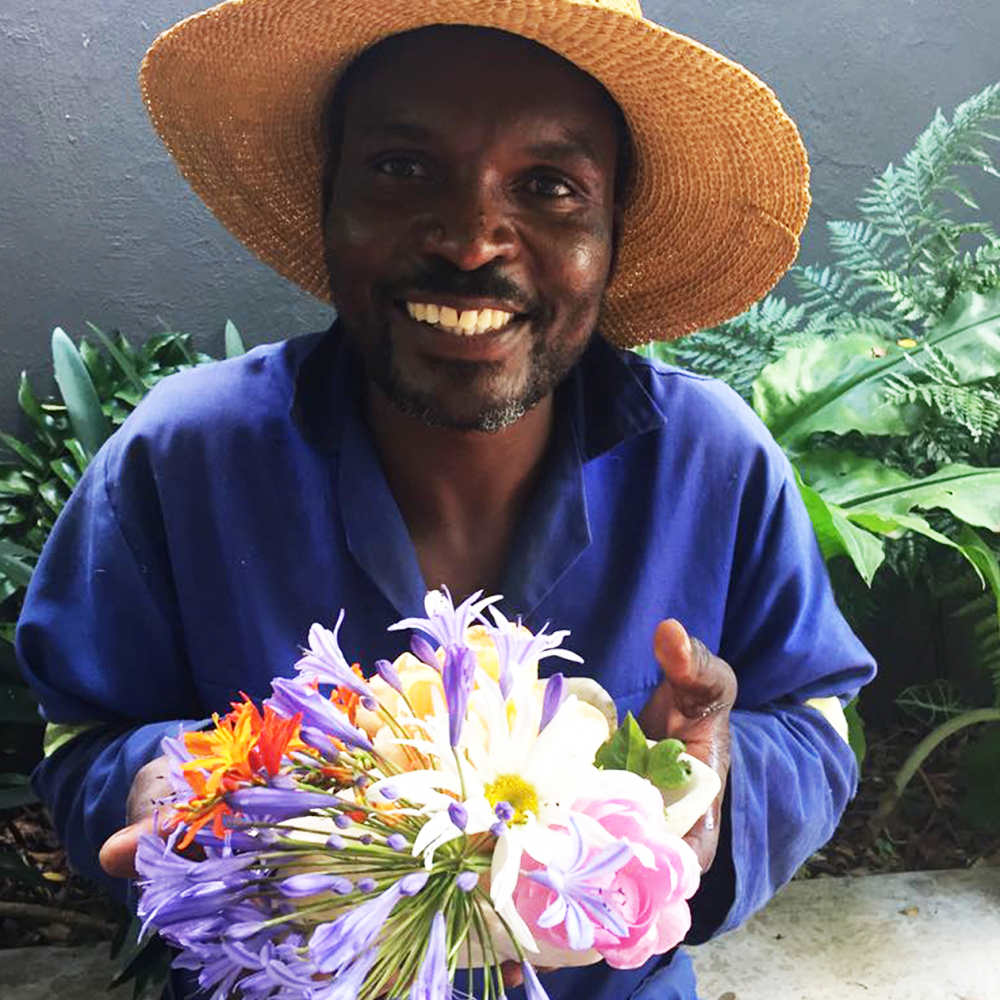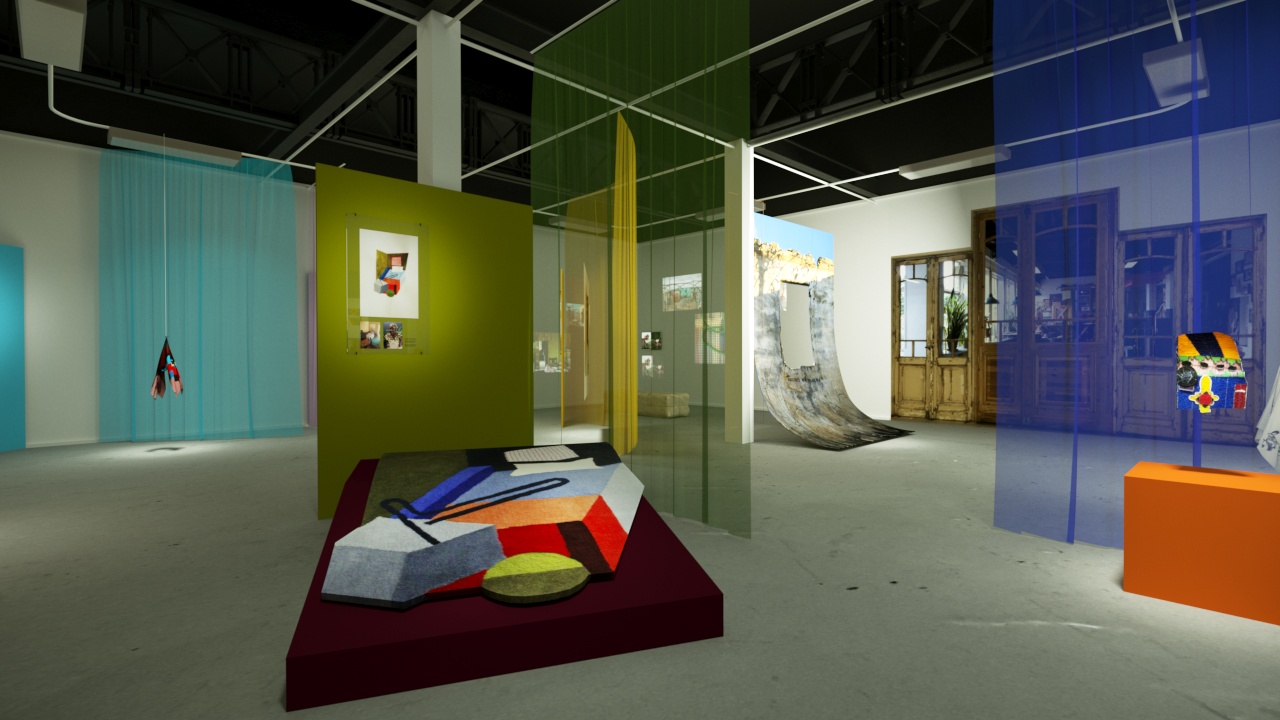In exhibition ‘Tussen Wal en Schip’, TAC resident Pascale Theron explores her notion of home as she feels stuck between two places. The project mirrors the artist’s position within the world, and is a response to the feeling of being lost somewhere ‘tussen wal en schip’. For our newest Backstage we spoke to Pascale Theron and set designer Millie Herpin to talk about the story behind the exhibition and the multidisciplinary collaboration that created the colourful outcome.
About the artists
Pascale Theron’s work falls somewhere between art, craft and design. Being born and raised in South Africa, now working in The Netherlands, both have influenced her creative career. Delving into research and connecting with people from different backgrounds, she attempts to create a bridge between cultures. She often works with soon-to-be-lost handmade crafts, highlighting how it is important to create meaningful and intuitive pieces that are sensitive and genuine. Pascale Theron makes controversial conversational pieces that acknowledge the past, confront the present, and imagine a brighter future.
Millie Herpin is a French creative with a passion for images: fixed, patterns, and motion. She graduated with a BA in textile and surfaces in Paris (2013). At the Design Academy of Eindhoven, she specialised in communication with a minor in colour & space (2018). Her graduation project: Bliss.bis is a bridge between these domains and her first step towards set-design. Her speciality is her use of colour, highlighted in “Background Noise” at the Broken White exhibition (Van Abbemuseum, 2016). Now, she is a set-design freelancer, and uses textile, communication and colour to create atmospheres and strong identities.

The first thing I noticed when entering the exhibition is the platform with jewels and gems. How does the grey corner relate to the rest of the colourful exhibition?
Pascale: We’ve been calling it a museum, but it’s not really a museum. It’s an archive that contains all the artifacts that build up to the beginning and end of this project. It is all objects from my own personal collection that have been given, are brought back from South Africa or handmade. Some of them are samples of the pieces you see in the exhibition.
Millie: In terms of the set design, it is also important for the exhibition to show the background of Pascale since it is a rather personal project. The archive shows the visitor what inspires Pascale’s work and introduces them to what’s to come in the exhibition. The corner is made grey so it doesn’t blend with the colourful contexts in the exhibition.
In ‘Tussen Wal en Schip’ we see six contexts that tell the story of an individual and their home. How are these people connected to you as a person and artist?
Pascale: In the beginning of the exhibition you will find the ‘white guilt quilt’. The blanket depicts 20 people that have brought me up throughout my life in South-Africa. Six of the people that are on that blanket are six of the people you will find in the exhibition. I could do all 20 of them, but then it would become an enormous exhibition. Josephine, one of the people you’ll find on the blanket and exhibition, is no longer with us. We took the photographs of her home – that inspired the piece in the exhibition – some years back when we went to visit her.
They are very connected to me as they have brought me up in South Africa. In South-Africa there is a lot of poverty. A lot of people are looking for jobs, and those jobs often turn out to be domestic workers. Half the people you’ll find on the blanket and exhibition are workers from our farm in the Free State, a rural area where most people only speak Afrikaans; the language that sounds like Dutch. Most of them can’t read or write. They are educated to work on the land for example as a farmer. The new generation on the other hand can read, write and speak fluent English. This is how you can really see the impact of the changed education system in South Africa. It is still common for me to not understand people on the streets, as there are 11 official languages in South Africa.


Are all the people in the exhibition from South Africa?
Pascale: There are two people in the exhibition that represent Zimbabwe. You hear them a lot in the video of the exhibition as they have the same feeling of home and where to belong. For example, Dominic on the orange board with the T-shirt is from Zimbabwe and moved to South Africa when he was 18 years old. He considers himself to be Zimbabwean, but still asks himself where do I belong. You can also see it in the pictures of his home; it is not situated, but somewhat disheveled and quite temporary.
"I used to wake up with her face and go to bed with her face."
Besides being an inspiration, how were the people we see, involved in creating the exhibition?
Pascale: Florah, who is Zimbabwean as well, was the starting point of the exhibition. She beaded the beads in the carpet of my graduation project and is very creative. So there has been a lot of going back and forth. Florah’s story is that she came to South Africa illegally to get a job. Many people don’t know the overall living conditions in Zimbabwe are not that great. There is a lot of poverty, people starving and their currency is really low. Since they can’t even afford bread and sugar, Florah is taking home every penny she earns. She sends a package with money and food supplies to Zimbabwe each month that feeds her family.
In the exhibition you will connect the faces to the context, and then the textile works, but the video lets you hear the voice and story behind that person. Florah is actually one of our domestic workers and has been with us for over ten years. I used to wake up with her face and go to bed with her face. She is in the house all the time. Dominique is the person that works in our garden, and Mpho used to drive me to school five days a week.
Does the ‘white guilt quilt’ keep on growing with new people?
Pascale: So far not, since there has been no one new for the past 10 years. There are some people on the blanket that are no longer with us. The quilt is a memorium of them and what made me the person I am today. That’s why I’m wrapped in it in the picture you see of me when entering the exhibition. They are also my family, the people I grew up with, and brought me up as a white South African woman. That is why their descriptions and video fragments are so important, as they are bringing life to the stories. Important for the exhibition was the tone of voice. They needed to be familiar as they invited us and opened up their homes to us. They are proud of what they created for themselves, which makes me feel proud to be a part of.
Did the research for your exhibition redefine your notion of home?
Pascale: ‘Tussen Wal en Schip’ is made at the right time since I am now in the phase of giving up my South African identity to transit to a Dutch passport. The exhibition is all about my identity and past versus present. Where do I come from and where do I belong?
Millie: When I heard the story, I immediately thought that a lot of people can relate to it. Especially in Eindhoven, which has the TU/e, Hightech Campus, Philips and ASML. Everyone is from everywhere. I think you make home the place where you live, but in the process you take things from the past with you. You pick what you like and in the end it’s the mix of cultures and backgrounds that defines your home and identity.
We have mentioned colour before. What is the importance and meaning of colour for the exhibition?
Millie: The colours are picked from Pascale’s illustrations. Each atmosphere, each context and each colour represents one person. In South Africa you have a meaning for each colour, but that is not something we followed when picking the colours for these persons. They are just the visual base of the exhibition. It was a big choice to go full out with bright colours, because that is not something you usually see in a museum. Besides that, it was important that the colours were not too distracting from the story Pascale was telling. We wanted the colours to match with the identities and homes of the people in the exhibition. They are very much in contrast with the homes of people in the Netherlands In South Africa, each home is full of colour whereas here in the Netherlands, everything is white, grey and beige.
For the set design, there is always one colour for one context that makes the visitor really focus on that particular corner and the story that is told there. It is one unity.
"We wanted the colours to match with the identities and homes of the people in the exhibition."
’Tussen Wal en Schip’ is the result of a multidisciplinary collaboration. Did you guys collaborate before and what did you learn from each other?
Pascale: Me and Millie did the brand of it all, but besides us there was an entire team of people helping with the exhibition. It’s funny, because me and Millie were roommates from the very first day we arrived here in Eindhoven, fresh from the boat. We’ve been through a lot together being expats together, going to the same school and living together for three years. We knew each other’s story and work which really helped us. In the end it’s funny how TAC initiated the collaboration without knowing this background.
Millie: With the extra funding of Cultuur Eindhoven we were able to involve other people to help us. Gurritza made the digital renders of the exhibition according to my set design. Fellow TAC resident and designer Robin Weidner helped us with his carpentry skills to build up podiums and boards. The collaboration with Gurritza and Robin made it easier to visualize the exhibition, overcome obstacles with creative solutions and take things to the next level by making use of each other’s skills.



Tussen Wal en Schip
Exhibition ‘Tussen Wal en Schip’ is on show until Sunday 23 May and can be visited by appointment. Send an email to visit@tac.nu to visit on Thursdays, or contact Pascale Theron at pascale.theron.studio@gmail.com to make an appointment for visiting on Saturday or Sunday.